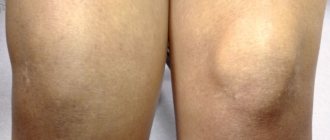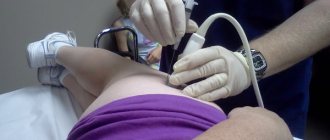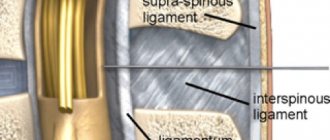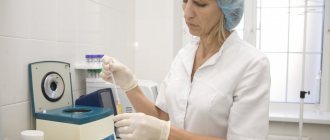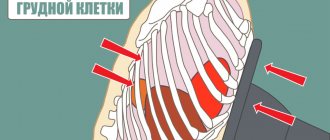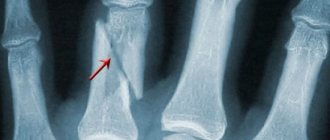A biopsy is a procedure during which a sample of pathologically altered tissue is obtained and examined under a microscope, as well as some tests are performed. The main purpose of this procedure is to identify abnormal cells and evaluate their characteristics. First of all, we are, of course, talking about malignant tumors.
Our expert in this field:
Sergeev Pyotr Sergeevich
Oncologist, surgeon, chemotherapist, Ph.D. Member of the international society of surgical oncologists EESG
Call the doctor Reviews about the doctor
A bone biopsy can be performed in one of two ways:
- Using a needle inserted through the skin. This procedure is usually performed under the guidance of computed tomography. MRI navigation is sometimes used.
- During the operation. An incision is made and part of the bone is surgically removed.
Modern doctors adhere to a gentle approach: the optimal way to obtain bone tissue for research is a needle biopsy. If too much tissue is removed, it can lead to a pathological fracture.
Advantages of core needle bone biopsy:
- This procedure allows you to obtain a result no less accurate than an open biopsy during surgery.
- A needle biopsy is minimally invasive and avoids severe tissue trauma.
- This procedure is performed under local anesthesia - unlike surgery, no anesthesia is required.
- There is a very short recovery period after it. The patient can return to normal life as quickly as possible.
It is important to carry out the procedure correctly, to obtain tissue from the right place and in sufficient quantity to establish an accurate diagnosis. A bone biopsy should be performed by a doctor who has relevant experience. At the international clinic Medica24, this manipulation is performed by highly qualified surgeons. Our doctors carefully evaluate the indications and potential risks in advance.
Do not confuse bone biopsy with red bone marrow. In the first case, bone tissue is examined, in the second - cells of hematopoietic tissue.
In what cases is a bone biopsy necessary?
Bone biopsy helps solve the following problems:
- Establish the nature of the pathological formation that was detected on x-rays, based on the results of CT or MRI.
- Confirm the diagnosis of bone lesions if this cannot be done by other means.
- Conduct a differential diagnosis between bone tumors and other diseases, for example, of an infectious nature.
- Conduct differential diagnosis between benign and malignant bone tumors.
- Understand the causes of inflammation and infectious process, if this cannot be done in other ways.
- Identify the cause of long-term painful pain in the bones, if this cannot be done in other ways.
Indications for the procedure are determined by the doctor based on the specific clinical situation. You can get advice from one of the leading specialists at the international clinic Medica24.
Interpretation of sternal puncture results
Analysis of bone marrow obtained through sternal puncture shows the number of cellular elements in it, their ratio and degree of maturity. The myelogram characterizes the qualitative and quantitative indicators of the white germ of hematopoiesis:
- Myelokaryocytes (the total number of blood cells containing nuclei) are 50-250x109 per liter of blood;
- Megakaryocytes (precursors of platelets) - 0.054-0.074x106 per liter;
- Reticulocytes (precursors of red blood cells) make up 20-30% and increase with blood loss and hemolytic anemia;
- Blast cells - 0.1-1.1%, myeloblasts - 0.2-1.7%, promyelocytes - 0.5-8.0% of all elements of the white sprout of the bone marrow, lymphocytes - 1.2-1.5 %, monocytes - 0.25-2.0%, plasma cells - no more than 1%.
A decrease in the number of myelokaryo- and megakaryocytes is possible due to errors in the puncture, when the bone marrow is diluted with liquid blood.
The specialist studying the bone marrow punctate reflects in the conclusion the type of hematopoiesis, cellularity, bone marrow indices, the presence and number of uncharacteristic cells (for example, Hodgkin's in lymphogranulomatosis). Each of the sprouts is analyzed separately.
Contraindications
The doctor may refuse to perform a bone biopsy in the following cases:
- Severe general condition of the patient. Needle biopsy is difficult in patients who cannot remain still during the procedure. For example, these are people with impaired consciousness and erratic motor activity, and mentally ill people.
- Immunodeficiency conditions in which invasive procedures carry a high risk of infection.
- Severe bleeding disorders, taking anticoagulants.
With a puncture biopsy, it is not always possible to gain access to the affected area of the bone and remove the required amount of pathologically altered tissue from the desired location. In such cases, if a biopsy cannot be avoided, surgery will have to be performed.
Indications and contraindications for sternal puncture
The reason for examining bone marrow aspirate obtained from the sternum is suspicion of hematological diseases, a planned bone marrow transplant, or some infectious processes when other routine examinations do not provide sufficient information. Sternal puncture is performed when:
- Anemia - severe iron deficiency, megaloblastic, aplastic.
- Tumors of hematopoietic tissue - leukemia, paraproteinemic hemoblastosis.
- Myelodysplastic syndrome.
- Leukemoid reactions, when the peripheral blood picture does not exclude tumor growth.
- Storage diseases of hereditary nature, metabolic disorders (Gaucher disease, Niemann-Pick disease).
- Visceral leishmaniasis.
- Suspicion of the presence of metastases of other malignant neoplasms in the bones (prostate cancer, for example).
- Assessing the effectiveness of treatment and monitoring the condition of hematological patients.
- Research and procurement of the resulting stem cells for transplantation to a donor or the punctured patient himself after courses of chemotherapy or radiation.
- Intraosseous administration of drugs.
An established diagnosis of chronic leukemia in the acute stage, as well as iron deficiency anemia, diagnosed through routine examinations, serve as relative indications for bone marrow puncture, that is, in these cases, the procedure can be abandoned.
There are also contraindications to sternal puncture:
- Severe bleeding disorders.
- Old age in cases where sternal puncture is not the only possible diagnostic method.
- Acute inflammatory and infectious lesions at the site of the intended skin puncture.
- Patient refusal to study.
- Severe concomitant diseases in the stage of decompensation (the question of the advisability of a puncture is decided individually).
Preparation for the procedure
First, the doctor consults the patient, talks about how the bone biopsy will take place, and why it is needed. The doctor will also answer all questions in detail. In turn, the patient must tell the doctor about his concomitant diseases, allergic reactions to medications, latex, and what medications he regularly takes. If a patient is being treated with medications that reduce blood clotting and prevent blood clots, they may need to be stopped for a while.
Before a bone tissue biopsy, you need to undergo a standard preoperative examination: take blood and urine tests, check for some infections, undergo an ECG, fluorography, and consult a therapist. The scope of the examination depends on how the biopsy is planned to be performed.
If a fragment of bone tissue is removed during surgery under general anesthesia, then you should not eat or drink 10–12 hours before surgery.
Request a call back. We work around the clock
Message sent!
expect a call, we will contact you shortly
Bone marrow aspiration biopsy
Bone marrow aspiration biopsy:
pancytopenia; single or double lineage cytopenia of unknown etiology; the presence of immature cells in the peripheral blood, especially blasts; an increase in the number of blood cells of unknown etiology; monoclonal gammopathies, focal osteolytic changes of unknown etiology during radiological studies; differential diagnosis of fever, enlarged spleen or lymph nodes, unknown etiology; differential diagnosis of storage diseases and metabolic diseases; acute leukemia, myelodysplastic syndromes, myeloproliferative and lymphoproliferative tumors; monitoring the effects of treatment for diseases of the hematopoietic system; assessment of hematopoiesis recovery after hematopoietic cell transplantation; assessment of the constitutive karyotype in cases where it is impossible to assess based on the analysis of peripheral cells; assessment of iron stores in case of pathological laboratory results.
Contraindications Aspiration biopsy: There are no absolute contraindications. Relative contraindication: thrombocytopenia.
Complications
Fracture of the needle or separation of the needle from the handle, prolonged bleeding (can be massive), local inflammatory process. Associated with sternal biopsy (also not common): pneumopericardium, right ventricular or right atrium puncture and cardiac tamponade, aortic injury, pulmonary embolism (fat), mediastinitis, mediastinal emphysema.
Patient preparation
- No more than 5-10 days before the manipulation, do a UAC, cogulogram.
- All medications (especially anticoagulants) are canceled, except those that are vital;
- Two hours before the puncture, the last meal and water is possible;
- Before the procedure, the bladder and intestines are emptied;
- It is allowed to take analgesics and sedatives before the procedure.
- Indicate any allergies to medications.
Bone marrow puncture and trephine biopsy in children are performed only under general anesthesia in the intensive care unit.
Equipment
- Equipment for preparing the surgical field:
- — Alcohol 70%
- - Iodine
- — Cotton balls
- Equipment for infiltration anesthesia:
- -Lidocaine solution for injection
- — Novocaine solution for injection
- -Cold to the puncture site after trepanobiopsy
- — Pressure bandage
- Biopsy needles, 3 types:
- for aspiration biopsy in the sternum (Kassirsky needle for sternal puncture - thin)
- aspiration biopsy of the iliac wing area (bone marrow puncture needle)
- for trephine biopsy.
- Syringes 10 and 20 ml
- EDTA (ethylenediaminetetraacetic acid) tubes for immunophenotyping and genetic tests.
- Tubes with lithium heparin (if the bone marrow is clotting)
- Slides for making smears
- Test tube with farmalin (10% solution) for trepanobiopsy aspirate.
Place of puncture
1. Wing of the ilium:
1)
the superior posterior iliac spine where the iliac crest is closest to the skin, usually 5–15 cm from the midline of the body (this location is preferred due to the lowest risk of complications);
2)
the iliac crest adjacent to (1–2 cm posterior to) the anterior superior iliac spine.
During one procedure, aspiration and trephine biopsy can be performed. If both tests are performed in the same place, use 2 different needles inserted at a distance of 0.5–1 cm; material is not aspirated through the trepanobiopsy needle.
2. Sternum -
body of the sternum in the midline, at the level of the second intercostal space, slightly below the angle of the sternum (higher risk of complications; only for aspiration biopsy; preferred location for pelvic radiation therapy or dry puncture of the femur, and also in the absence of indications, for trephine biopsy).
Method of performing aspiration biopsy
- Prepare the surgical site
- Perform infiltration anesthesia of the skin, subcutaneous tissue and periosteum at the puncture site
- Wait 2–5 minutes.
4. Femoral spine
hold with one hand, with the other, perform a puncture to a depth of 15–20 mm.
When performing a puncture of the posterior spine, point the needle perpendicular to the surface of the skin, and when puncturing the crest of the anterior spine - at an angle of 45–60°. the sternum
perpendicular to its surface to a depth of 10–15 mm. Perforate the bone by pressing on the needle and simultaneously performing rotational movements along the axis of the needle (least pain); entry of the needle into the bone marrow cavity is accompanied by a feeling of failure (loss of resistance).
5.
Remove the mandrin and set it aside on a sterile napkin so that it can be reused if bone marrow is not obtained and a repeat puncture becomes necessary.
6.
Connect the needle tightly to a sterile syringe and perform aspiration (stabbing pain during aspiration indicates the correctness of the puncture and the presence of the needle in the bone marrow cavity).
7.
Remove the biopsy needle and attached syringe from the bone using a rotating motion (if you remove the needle too vigorously, you may break it or detach it from the handle).
6.
Apply a sterile dressing for 6–12 hours.
How is a bone biopsy performed?
Needle biopsy is usually performed under local anesthesia, and bone surgery is performed under general anesthesia. In some cases, spinal anesthesia is used: an anesthetic is injected under the membranes of the spinal cord. In this case, the sensitivity below the injection site is turned off.
Core needle biopsy of bone
During this procedure, the patient is positioned in such a way as to provide the doctor with easy access to the desired bone. The skin in the puncture area is treated with an anesthetic solution. Then they give an injection and apply local anesthesia.
A computed tomography scan is performed to assess the location of the pathological formation and select the correct puncture site. The doctor makes a small incision in the skin and inserts a special hollow needle into the bone to collect material under CT guidance. It is not painful: usually only slight discomfort and pressure are felt when the needle is inserted.
After the needle is removed, pressure is applied to the puncture site for several minutes to stop the bleeding. Then apply a sterile bandage. Sutures are usually not needed. The patient is observed, usually for several hours. A control x-ray is performed to ensure there are no complications. After this, the patient is sent home.
In total, a core needle biopsy takes from 30 minutes to 1 hour. Its duration depends on the size of the pathological lesion and how difficult it is to access it with a needle.
Biopsy during surgery
During an open bone biopsy, the patient is taken to the operating room and placed under general anesthesia or spinal anesthesia. The doctor makes an incision, accesses the affected bone and removes the required amount of tissue. The wound is then covered with stitches and a sterile dressing.
Preparation and technique for performing sternal puncture
Sternal puncture is not a complex procedure; it is safe, does not require anesthesia and is performed both in a hospital and on an outpatient basis. Preparation for sternal bone marrow aspiration is extremely simple:
- The patient undergoes a blood clotting test and a general analysis no more than 5 days before the planned manipulation;
- Two hours before the puncture, the last meal and water is possible;
- Before the procedure, the bladder and intestines are emptied;
- All medications are canceled, except those that are vital;
- On the day of the puncture, no other procedures are prescribed.
Before the manipulation, the patient must inform the doctor about all the medications he is taking, especially for anticoagulants and other blood-thinning agents, which should be discontinued due to the greatly increasing risk of bleeding while taking them.
The specialist who will perform the sternal puncture will find out information about the presence of allergies to medications, since the administration of anesthetics will be required. The patient is told in detail about the essence of the puncture, its purpose and the meaning of the upcoming operation. The doctor warns about the possible pain of the puncture and subsequent precautions. It is mandatory to obtain the written consent of the person being examined (or the parents during a puncture of the child) to carry out the procedure.
The technique of performing sternal puncture includes several stages:
Lay the patient on his back and place a cushion under his shoulder blades.- Treatment of the puncture site with antiseptic solutions (iodine, ethanol); in men, the hair is shaved.
- For pain relief, local anesthetics (lidocaine, novocaine) are injected into the skin, subcutaneous tissue and periosteal space, since a puncture is a rather painful event, especially when the needle passes through the periosteum.
- The puncture is performed at the level of attachment to the sternum of the third or fourth rib, along the midline, using a Kassirsky needle, which is inserted into the bone with a quick twisting motion. When the bone marrow enters the receptacle, the doctor will feel a dip, which indicates that the needle is passing through the surface of the bone. When the needle is immersed through the compact bone layer and the bone marrow is aspirated, the patient will feel a short-term pain.
- When the needle is in the medullary canal of the sternum, a syringe is connected to it, through which the doctor aspirates 0.3 ml of bone contents.
- After obtaining the required volume of hematopoietic tissue, the needle is removed, and a sterile napkin or patch is applied to the puncture site.
Special precautions should be taken when puncturing the sternum in children. Their bone is softer and more elastic, so careless actions can pierce it through. If possible, the child should be immobilized so that his movements do not disrupt the process of puncture of the sternum.
Features of sternum puncture in children:
- Sternal puncture is possible only from two years of age;
- Special needles of smaller diameter than for adults are used;
- General anesthesia is possible.
Elderly people, patients receiving long-term corticosteroid drugs may suffer from osteoporosis, so precautions for through puncture, which is possible due to a decrease in bone tissue density, also apply to them.
The sternum puncture procedure is rarely performed without anesthesia - if it is unavoidable, and the patient has absolute contraindications to the administration of anesthetics. In such a situation, the patient is warned about the painfulness of the manipulation; it is possible to use tranquilizers before the procedure and analgesics.
The bone marrow obtained by puncturing the sternum is placed on a glass slide, then a cytological preparation is prepared, which is assessed by a cytologist. When diagnosing hematological pathology, the latter pays attention to the structure of blood cells, their number, degree of maturity, and the ratio of various elements in the total volume of punctate.
Bone marrow extracted from the sternum can also be subjected to cytochemical, immunological, and histological examination. Histological assessment of punctate provides more opportunities to assess the ratio of fatty and active bone marrow, the state of the vascular component and cellular elements of varying degrees of maturity.
The results of a sternal puncture can be obtained on the same day if a cytological examination of a bone marrow smear is expected. With histological analysis and other more technically complex studies, the diagnosis is extended for a period of 7-10 days.
The above method of sternal puncture was proposed in 1927 by Arinkin M.I. and is still practiced to this day. The Kassirsky needle has been successfully used by hematologists for decades. It is durable, wide, has a removable handle that is convenient for insertion, and is also equipped with a limiter that prevents the needle from moving too deeply.
Video: sternal puncture technique
Recovery period
After a needle biopsy, the recovery period is very short.
After surgery, the patient is discharged from the hospital the next day or later, depending on the extent of the operation. In the future, at home, you need to make sure that the bandage remains clean. The sutures are removed a few days later, during the next dressing.
For several days, pain may occur at the site of bone tissue collection; this can be relieved using regular painkillers from your home medicine cabinet. Your doctor may recommend limiting physical activity over the next few days.
If some symptoms appear after a bone biopsy, you should immediately consult a doctor:
- Prolonged, increasing pain.
- Redness, swelling at the puncture or surgery site.
- Increased body temperature to 38 degrees, chills.
- Fluid is released profusely from the intervention site.
Complications and features of the postoperative period
The procedure for collecting bone marrow lasts approximately 20 minutes, after which the patient is under observation for about an hour, general health, pulse and blood pressure are monitored. You can leave the hospital the same day, but it is highly undesirable to drive, as there is a risk of fainting.
The puncture site does not require any treatment at home, however, for the first three days it is recommended to exclude water procedures so as not to introduce an infection into the puncture hole. Sternal puncture does not imply any restrictions on diet and nutrition. If there is severe pain at the puncture site, the patient can take a painkiller.
Following the precise technique of sternal puncture, using a Kassirsky needle with a limiter, and treating the puncture site with antiseptics virtually eliminates the likelihood of complications. In rare cases, adverse consequences are possible in the form of:
- Through puncture (in a child or patient with osteoporosis);
- Bleeding from the puncture site;
- Infection of the puncture site (extremely rare);
- Fainting states in emotionally labile persons, hypotensive persons, with insufficiently thorough psychological preparation of the patient for manipulation;
- Shock in case of severe pathology of the cardiovascular system in elderly people.
In general, the sternal puncture procedure is easily tolerated and is extremely rarely accompanied by complications. Feedback from patients is mostly positive, and well-being and attitude towards the manipulation largely depend on the quality of preparation and competent conversation between the doctor and the patient. Some people note severe pain at the time of puncture and removal of material from the sternum, and in the next 2-3 days, others feel only slight discomfort.
Possible complications
In general, a bone biopsy is a safe procedure. The most common complications include bleeding, infection, and loss of movement or sensation in a specific part of the body due to nerve damage. If a bone is severely weakened by a malignant tumor and too much tissue is removed, a pathological fracture may subsequently occur - damage to the bone from minor stress.
When using anesthesia, some patients develop allergic reactions to the anesthetic - this happens very rarely.
The experience, high level of qualifications of doctors and modern equipment of the international clinic Medica24 allow us to perform bone biopsies and other invasive surgical interventions with minimal risks.
Find out more. Request a call back
Message sent!
expect a call, we will contact you shortly
How are the results of a bone biopsy evaluated?
The resulting tissue sample is sent to a laboratory where it is examined under a microscope. Usually the result comes within a few days. During the re-appointment, the doctor examines the pathological report, establishes the final diagnosis and determines further treatment tactics.
The international clinic Medica24 uses the services of the best pathological laboratories. Based on the results of the study, patients are advised by leading doctors. All the most modern methods of treating benign and malignant bone tumors are available in our clinic. Our doctors use the latest generation of drugs and perform surgical interventions of any complexity in a well-equipped operating room.
The material was prepared by the deputy chief physician for medical work of the international clinic Medica24, candidate of medical sciences Sergeev Petr Sergeevich.
